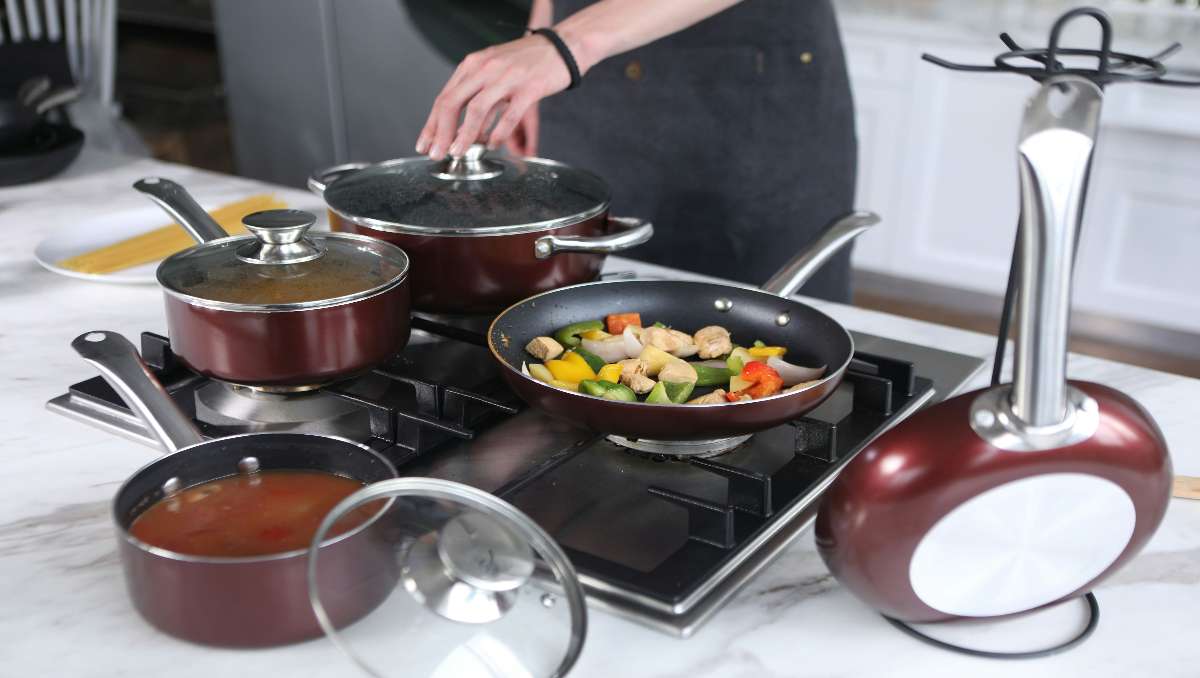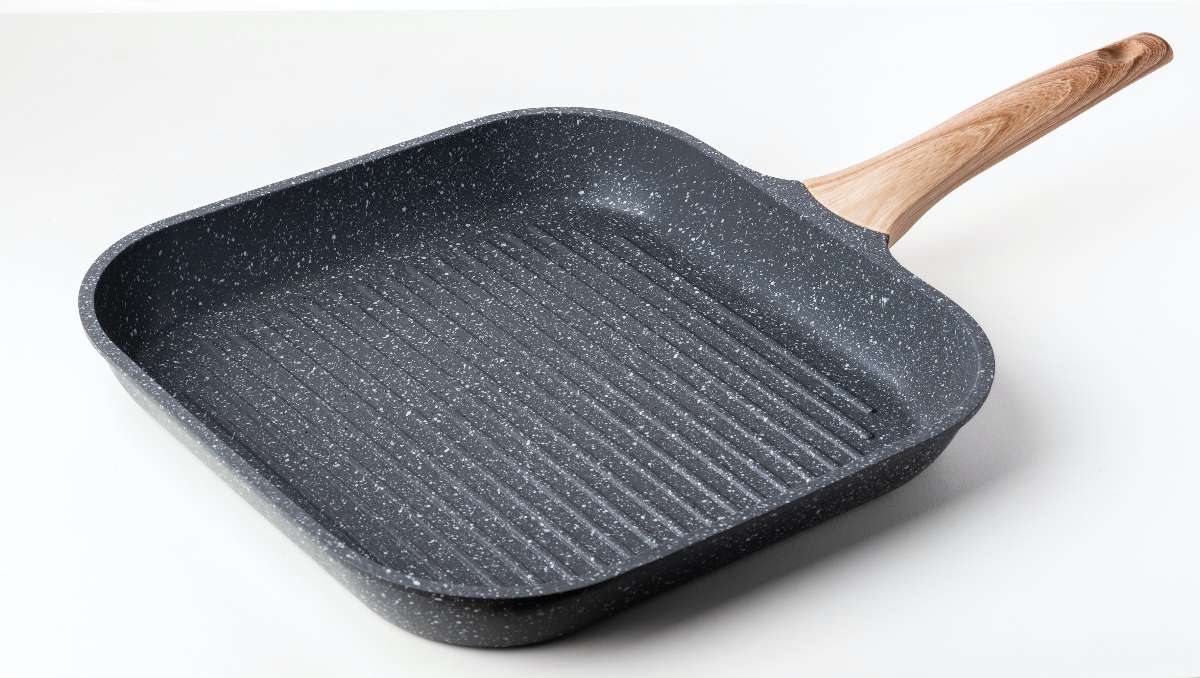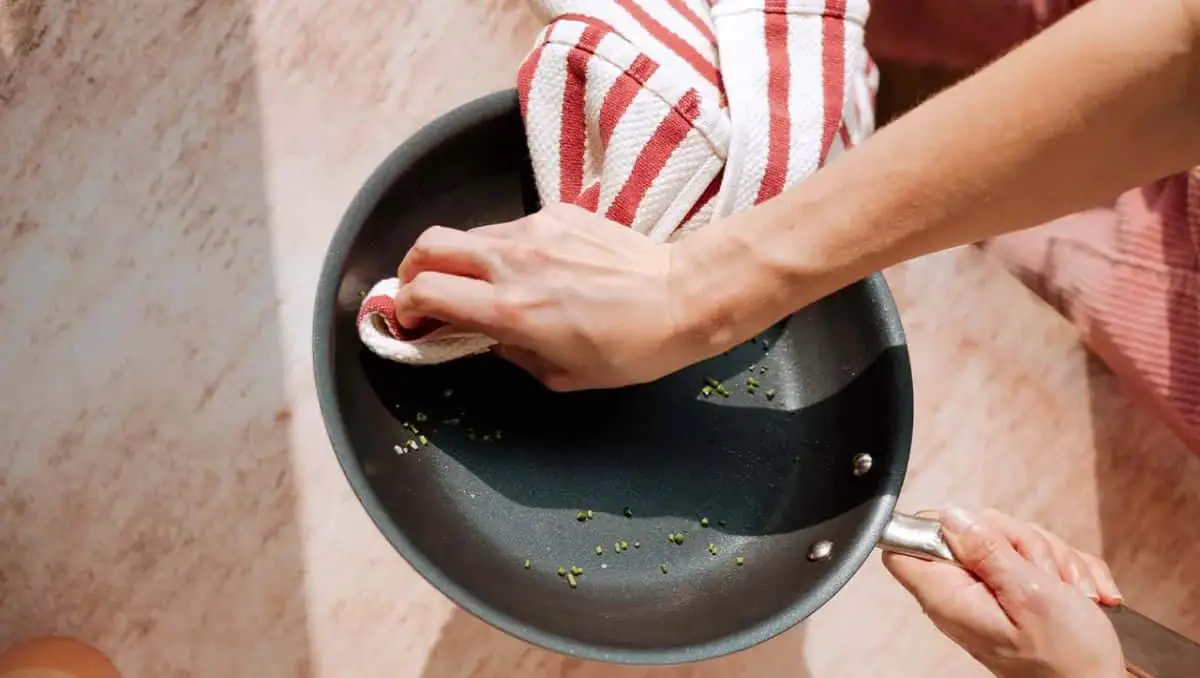In modern convenience and innovation, Teflon has emerged as a ubiquitous material, finding its way into many everyday items. Initially discovered in the 1930s, Teflon revolutionized how we cook and interact with various products. Its non-stick properties and resistance to high temperatures have made it a staple in kitchenware, but its applications extend far beyond the culinary domain.
Teflon is commonly found in non-stick cookware such as frying pans and baking sheets. Beyond the kitchen, Teflon is also used in industrial applications, electrical insulation, gaskets, and seals due to its resistance to high temperatures and chemicals.
In this article, we delve into the diverse array of items that incorporate Teflon, uncovering the unexpected places where this versatile material plays a crucial role. From cookware to industrial machinery, Teflon’s influence is pervasive, quietly enhancing the functionality of items we often take for granted.
What is Teflon?
Teflon, a trade name for polytetrafluoroethylene (PTFE), is a testament to the marvels of modern materials science. Discovered in 1938 by chemist Roy Plunkett, Teflon has become synonymous with non-stick surfaces and high-temperature resistance.
At its core, Teflon is a synthetic fluoropolymer of tetrafluoroethylene, composed of carbon and fluorine atoms arranged in a highly stable molecular structure. This unique arrangement contributes to Teflon’s exceptional properties.
Teflon’s remarkable non-stick quality arises from its molecular structure, which features a chain of carbon atoms surrounded by fluorine atoms. This configuration creates a surface with low surface energy, making it difficult for other substances to adhere to.
Consequently, applying Teflon as a coating imparts a non-stick characteristic to surfaces, reducing the need for excessive oil or butter in cooking.
One of Teflon’s standout features is its ability to withstand high temperatures without undergoing significant structural changes. This property makes it ideal for applications in cooking utensils, industrial machinery, and various other environments where exposure to extreme heat is a concern.
Common Items with Teflon Coating
Teflon, renowned for its non-stick properties and resilience, has found a pervasive presence in various everyday items.
| Common Items With Teflon Coating | Items | Images |
|---|---|---|
Cookware and Kitchen Appliances | Non-stick pans | 
|
| Baking sheets | 
| |
| Griddles | 
| |
| Waffle makers | 
| |
Industrial Applications | Machinery components | 
|
| Bearings and gears | 
| |
| Seals and gaskets | 
| |
Consumer Electronics | Cables and connectors | 
|
| Insulation for electronic devices | 
| |
Automotive Industry | Engine components | 
|
| Brake systems | 
| |
| Transmission parts | 
|
Cookware and Kitchen Appliances
Among the many applications, Teflon-coated items in cookware and kitchen appliances stand out, offering users a hassle-free and convenient culinary experience.

1. Non-stick pans
Non-stick pans, the most iconic use of Teflon, have revolutionized cooking by providing a surface that minimizes food adhesion. The Teflon coating allows easy flipping, stirring, and cleaning, making these pans an indispensable tool in kitchens worldwide.
2. Baking sheets
Baking sheets with Teflon coatings have become essential for baking enthusiasts. The non-stick surface ensures that cookies, pastries, and other baked goods can be effortlessly removed from the sheet, preserving their shape and quality.
3. Griddles
Teflon-coated griddles have become a breakfast staple. Whether cooking pancakes, eggs, or bacon, the non-stick surface ensures that your breakfast creations are easily prepared and just as easy to clean up.
4. Waffle makers
Waffle makers featuring Teflon coatings have transformed the waffle-making process. The non-stick surface ensures that waffles are golden and crispy while simplifying the cleanup process, allowing enthusiasts to enjoy their favorite breakfast treat with minimal fuss.
Teflon’s presence in cookware and kitchen appliances has elevated the cooking experience, providing a practical solution to the age-old challenge of preventing food from sticking to cooking surfaces. These items have become staples in households worldwide, showcasing the enduring impact of Teflon in our daily lives.
Industrial Applications
The application of Teflon in industrial settings goes far beyond its culinary fame, finding strategic placement in crucial components.

1. Seals and gaskets
The reliability of seals and gaskets is paramount in industrial environments, where exposure to extreme temperatures and harsh chemicals is common. Teflon’s resistance to chemicals and ability to maintain structural integrity at high temperatures make it an ideal material for seals and gaskets.
2. Bearings and gears
Teflon plays a pivotal role in improving functionality and reliability in the intricate world of bearings and gears. The low friction characteristics of Teflon coatings on bearings enable smoother rotation, reducing energy consumption and heat generation.
3. Machinery components
Teflon’s use in machinery components is a testament to its versatility. Teflon reduces friction between moving parts when applied as a coating, minimizing wear and tear. This extends the machinery’s lifespan and enhances its overall performance.
The industrial applications into machinery components, bearings, gears, seals, and gaskets exemplify the material’s adaptability and contribution to the seamless operation of diverse industrial processes. As industries evolve, Teflon remains a trusted ally, enhancing the efficiency and durability of machinery across a spectrum of applications.
Consumer Electronics
In the fast-paced realm of consumer electronics, where precision and reliability are paramount, Teflon has secured its place as a go-to material for enhancing performance and durability.
1. Cables and connectors
Teflon’s influence extends seamlessly into the intricate world of cables and connectors. Recognized for its excellent electrical insulation properties and resistance to wear and tear, Teflon-coated cables and connectors ensure optimal signal transmission.
Whether in charging cables for smartphones or complex wiring systems in electronic devices, Teflon’s presence guarantees a reliable and durable connection, crucial for the seamless functioning of our electronic gadgets.
2. Insulation for electronic devices
Teflon is a protective shield within the compact confines of electronic devices like smartphones, laptops, and tablets. Its exceptional thermal stability and high-temperature resistance make it an ideal insulation material.
By preventing overheating and providing a reliable barrier against electrical interference, Teflon insulation contributes to electronic devices’ longevity and optimal performance in our daily lives.
Automotive Industry
With its complex machinery and demanding performance standards, the automotive industry has embraced Teflon as a key player in enhancing various components.

1. Engine components
Under the hood of every vehicle, Teflon-coated engine components contribute to improved efficiency and longevity. Teflon’s low friction properties reduce wear on engine parts, ensuring smoother operation and enhanced fuel efficiency. Teflon’s presence in engine design has become integral to achieving optimal performance and minimizing maintenance requirements.
2. Brake systems
Teflon’s role in brake systems is paramount in the critical realm of automotive safety. Teflon coatings on brake pads and components reduce friction, ensuring consistent and responsive braking. This enhances safety and extends the lifespan of brake systems, providing drivers with reliable stopping power under various driving conditions.
3. Transmission parts
Within the complex machinery of a vehicle’s transmission system, Teflon coatings on parts like gears and bearings contribute to smoother gear shifts and increased durability. Teflon ensures transmission components work seamlessly together by minimizing friction, optimizing performance, and minimizing wear and tear over the vehicle’s lifespan.
Teflon’s diverse applications exemplify its adaptability and indispensability in both consumer electronics and the automotive industry. As technology advances and automotive engineering evolves, Teflon plays a crucial role in shaping the reliability and performance of the devices we depend on and the vehicles we trust on the road.
IV. Health and Environmental Considerations
As Teflon continues to be ubiquitous in various products, it is crucial to explore the health and environmental considerations associated with its usage.
Safety of Teflon in Consumer Products
Teflon, when used appropriately in consumer products, is generally considered safe. For example, the non-stick properties that make it popular in cookware contribute to a reduced need for cooking oils, promoting healthier food preparation.
However, it is essential to follow manufacturer guidelines, as overheated Teflon cookware can release potentially harmful fumes. Teflon is inert and does not react with food when used within recommended temperature ranges, providing a safe and convenient cooking experience.
Potential Health Risks Associated with Teflon Exposure

While Teflon is considered inert and stable, concerns arise when the material is exposed to high temperatures. At temperatures above 500°F (260°C), Teflon coatings may begin to break down, releasing fumes that can cause flu-like symptoms in humans—a condition known as polymer fume fever.
Prolonged or repeated exposure to these fumes may pose respiratory risks. As a precaution, it is advisable to use Teflon-coated products within their designated temperature ranges and to ensure proper ventilation in areas where these products are used.
Environmental Impact and Concerns
The production and disposal of Teflon have raised environmental concerns. The manufacturing process involves the use of perfluorooctanoic acid (PFOA), a compound that has been linked to environmental and health issues.
However, many manufacturers have phased out the use of PFOA in the production of Teflon, opting for alternative processes that are considered more environmentally friendly. Additionally, the longevity of Teflon-coated products reduces disposal frequency, contributing to overall waste reduction.
Recently, there has been an increased focus on developing eco-friendly alternatives and addressing the environmental impact of various materials, including Teflon.
As research and technology progress, manufacturers and consumers must stay informed about the safety practices surrounding Teflon use, ensuring a balance between its convenience and its potential impact on health and the environment.
Alternatives to Teflon
| Alternatives to Teflon | Materials | Pros | Cons |
|---|---|---|---|
Emerging Non-Toxic Alternatives | Ceramic Coatings | Non-toxic | Durability may vary |
| Scratch-resistant | Requires careful handling | ||
| Even heat distribution | |||
Cast Iron | Durable | Requires seasoning for maintenance | |
| Excellent heat retention | Heavy and may require extra care | ||
| Adds iron to food | |||
Stainless Steel | Non-reactive | Not inherently non-stick | |
| Durable and corrosion-resistant | May require more oil for cooking | ||
| Retains a sleek appearance | Conducts heat less efficiently | ||
Sustainable and Eco-Friendly Options | Bamboo-based Cookware | Rapidly renewable resource | May require careful maintenance |
| Lightweight and durable | Limited heat resistance | ||
| Natural non-stick properties | |||
Glass Cookware | Non-reactive and easy to clean | Fragile and may break easily | |
| Does not leach harmful chemicals | Not suitable for high-heat cooking | ||
| Retains heat well | |||
Carbon Steel | Durable and lightweight | Requires seasoning for maintenance | |
| Good heat retention | May corrode without proper care | ||
| Conducts heat evenly |
As awareness grows about the potential concerns associated with Teflon, the search for alternatives has gained momentum. From emerging non-toxic options to sustainable and eco-friendly alternatives, the market is witnessing a shift toward materials that balance functionality with environmental and health considerations.
Emerging Non-Toxic Alternatives
Many non-toxic alternatives to Teflon have emerged in the market in recent years.
Ceramic coatings
Ceramic coatings have emerged as a popular alternative to Teflon in cookware. These coatings are often made from inorganic materials and boast non-stick properties without using PFOA or PTFE. Ceramic-coated pans and pots are becoming increasingly prevalent, offering health-conscious consumers a non-toxic and scratch-resistant option.
Cast iron

Time-tested and durable cast iron cookware has seen a resurgence in popularity. While it requires proper seasoning for optimal non-stick performance, cast iron offers an excellent alternative to Teflon without synthetic coatings. It is also known for its ability to retain and evenly distribute heat.
Stainless steel
Although not inherently non-stick, stainless steel cookware is reliable and durable; many chefs appreciate its versatility and the absence of chemical coatings. For those who prefer a minimalist and straightforward approach to cooking, stainless steel is a popular option.
Sustainable and Eco-Friendly Options
Aside from the non-toxic alternatives, there are also sustainable and eco-friendly options.
Bamboo-based cookware
Bamboo, a rapidly renewable resource, is finding its way into producing kitchen utensils and cookware. Bamboo-based alternatives offer a sustainable option with a minimal environmental footprint. The material is lightweight, durable, and often coated with natural oils for a non-stick surface.
Glass cookware
Glass is a safe and eco-friendly choice for cookware. It is non-reactive, easy to clean, and free from harmful chemicals. Glass baking dishes and cookware are suitable for various culinary applications, making them a preferred option for those seeking sustainable alternatives.
Carbon steel
Similar in performance to cast iron, carbon steel cookware has gained popularity as a non-toxic alternative to Teflon. It requires seasoning to maintain its non-stick properties and is prized for its durability and heat distribution.
As technology and innovation continue to drive change, the landscape of kitchenware is likely to see further diversification in the quest for safe and eco-conscious alternatives to Teflon.
Tips for Caring for Teflon-Coated Items
While known for their non-stick convenience, Teflon-coated items require specific care to maintain their effectiveness and longevity. Proper usage, regular maintenance, and mindful cleaning practices can significantly extend the life of Teflon-coated cookware and other items.
Proper Usage and Maintenance
You can extend the lifespan of your Teflon-coated items by following the proper usage and maintenance tips.
- Avoid High Heat: Teflon begins to degrade at high temperatures, so it is crucial to avoid exposing Teflon-coated items to excessive heat. Use low to medium heat settings during cooking to prevent the breakdown of the Teflon coating.
- Use Soft Utensils: When cooking with Teflon-coated pans, opt for utensils made of soft materials such as silicone or wood. Avoid using metal utensils, which can scratch and damage the Teflon surface, compromising its non-stick properties.
- Mindful Cooking Practices: Be mindful of cooking practices that may cause abrasion to the Teflon coating. Refrain from cutting food directly in the pan and avoid using abrasive scouring pads, as they can damage the non-stick surface.
- Regular Inspection: Periodically inspect Teflon-coated items for signs of wear or damage. If the coating shows scratches or chips or starts to peel, consider replacing the item to maintain food safety and optimal performance.
Cleaning and Storage Guidelines

There are specific guidelines for cleaning and storing your Teflon to make it long-lasting.
- Hand Wash Only: Teflon-coated items are best cleaned by hand. Avoid using abrasive scouring pads or harsh cleaning chemicals, as they can damage the non-stick coating. Instead, use a soft sponge or cloth with mild detergent to clean the surface.
- Avoid Cooking Sprays: While it might be tempting to use cooking sprays to enhance the non-stick properties, they can leave a residue on the Teflon surface over time. Stick to using small amounts of oils or fats as needed for cooking.
- Cool Before Cleaning: Allow Teflon-coated items to cool before cleaning. Rapid temperature changes can affect the integrity of the coating. For example, cleaning a hot pan under cold water may lead to warping or damage.
- Store Carefully: When storing Teflon-coated items, place a protective layer, such as a paper towel or soft cloth, between stacked pans to prevent scratching—store items in a cool, dry place.
By following these tips for proper usage, maintenance, cleaning, and storage, you can preserve the non-stick properties of Teflon-coated items and ensure their continued effectiveness. With some care and attention, Teflon-coated cookware can be a reliable kitchen companion for an extended period.
Teflon Unveiled: Beyond the Kitchen and Into Everyday Life
Teflon has proven an indispensable material, enhancing functionality and efficiency across diverse domains. Its prevalence extends beyond culinary applications, making its mark in consumer electronics and the automotive industry.
While Teflon offers undeniable convenience, the exploration also delved into the critical considerations of health and environmental impacts associated with its use. Acknowledging the potential risks of Teflon exposure at high temperatures, it becomes apparent that mindful usage and adherence to recommended guidelines are essential for ensuring safety.







